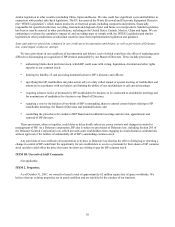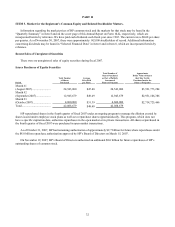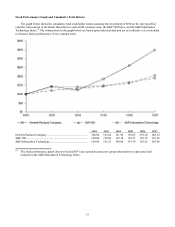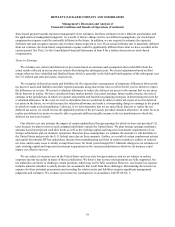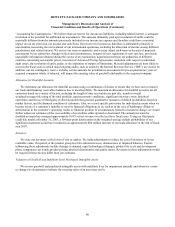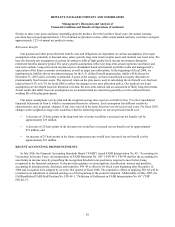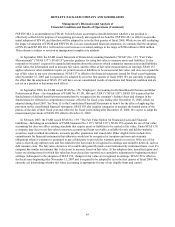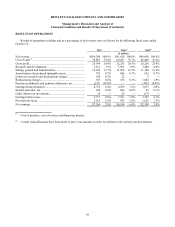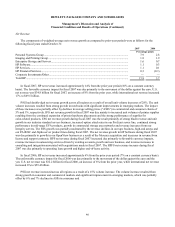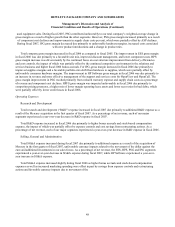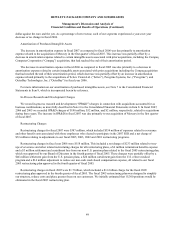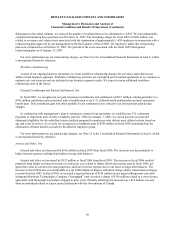HP 2007 Annual Report Download - page 54
Download and view the complete annual report
Please find page 54 of the 2007 HP annual report below. You can navigate through the pages in the report by either clicking on the pages listed below, or by using the keyword search tool below to find specific information within the annual report.HEWLETT-PACKARD COMPANY AND SUBSIDIARIES
Management’s Discussion and Analysis of
Financial Condition and Results of Operations (Continued)
“Accounting for Contingencies.” We believe that our reserve for income tax liabilities, including related interest, is adequate
in relation to the potential for additional tax assessments. The amounts ultimately paid upon resolution of audits could be
materially different from the amounts previously included in our income tax expense and therefore could have a material
impact on our tax provision, net income and cash flows. Our reserve for income tax liabilities is attributable primarily to
uncertainties concerning the tax treatment of our international operations, including the allocation of income among different
jurisdictions, and related interest. We review our reserves quarterly, and we may adjust such reserves because of proposed
assessments by tax authorities, changes in facts and circumstances, issuance of new regulations or new case law, previously
unavailable information obtained during the course of an examination, negotiations between tax authorities of different
countries concerning our transfer prices, execution of Advanced Pricing Agreements, resolution with respect to individual
audit issues, the resolution of entire audits, or the expiration of statutes of limitations. Material adjustments are most likely to
occur in the fiscal years in which major ongoing audits, such as audits by the Internal Revenue Service (“IRS”), are closed. In
addition, our tax contingency reserve includes certain amounts for potential tax assessments for pre-acquisition tax years of
acquired companies which, if released, will impact the carrying value of goodwill attributable to the acquired company.
Allowance for Doubtful Accounts
We determine our allowance for doubtful accounts using a combination of factors to ensure that we have not overstated
our trade and financing receivables balances due to uncollectibility. We maintain an allowance for doubtful accounts for all
customers based on a variety of factors, including the length of time receivables are past due, trends in overall
weighted-average risk rating of the total portfolio, macroeconomic conditions, significant one-time events, historical
experience and the use of third-party credit risk models that generate quantitative measures of default probabilities based on
market factors, and the financial condition of customers. Also, we record specific provisions for individual accounts when we
become aware of a customer’ s inability to meet its financial obligations to us, such as in the case of bankruptcy filings or
deterioration in the customer’ s operating results or financial position. If circumstances related to customers change, we would
further adjust our estimates of the recoverability of receivables either upward or downward. The annual provision for
doubtful accounts has averaged approximately 0.01% of net revenue over the last three fiscal years. Using our third-party
credit risk model at October 31, 2007, a 50-basis-point deterioration in the weighted-average default probabilities of our
significant customers would have resulted in an approximately $84 million increase to our trade allowance at the end of fiscal
year 2007.
Inventory
We state our inventory at the lower of cost or market. We make adjustments to reduce the cost of inventory to its net
realizable value, if required, at the product group level for estimated excess, obsolescence or impaired balances. Factors
influencing these adjustments include changes in demand, rapid technological changes, product life cycle and development
plans, component cost trends, product pricing, physical deterioration and quality issues. Revisions to these adjustments would
be required if these factors differ from our estimates.
Valuation of Goodwill and Indefinite-Lived Purchased Intangible Assets
We review goodwill and purchased intangible assets with indefinite lives for impairment annually and whenever events
or changes in circumstances indicate the carrying value of an asset may not be
40


